Apr 16, 2019
Last Updated on November 16, 2021 by allprotrailersuperstore
As the proud owner of a trailer, you know it requires diligent upkeep. And although you can do some of the necessary care and maintenance tasks yourself, in the comfort of your lot or driveway, others require a professional touch and call for you to bring your trailer into the mechanics to get it checked out.
While there’s certainly a time and an occasion for the professionals to get involved, however, there are several tasks responsible trailer owners should know how to perform themselves. One such task is knowing how to change a trailer tire. If you’ve never done that before, don’t worry. It’s more straightforward than it sounds, and is something anyone can quickly learn how to do.
Today, to help you learn this new skill, we want to walk you through the process from start to finish, as well as discussing how to recognize when to change a trailer tire and realizing when it’s time to call for a little professional assistance.
The most common reason you might need to replace a trailer tire is when you get a flat. Flat tires happen to all of us at one time or another, and there isn’t always a way to prevent them. Maybe you caused the flat by making a mistake somewhere along the line, but it might also result from circumstances beyond your control. The most common reasons for flat and damaged tires include the following.

Sometimes, it’s easy to know when you need to change a trailer tire. For example, if you’ve broken down on the side of the road with a flat tire, there’s usually no mistaking the problem. If it hasn’t quite come to this yet, however, you can still realize your tires need changing by looking for the following.
For example, if you’ve broken down on the side of the road with a flat tire, there’s usually no mistaking the problem. If it hasn’t quite come to this yet, however, you can still realize your tires need changing by looking for the following.

So you’ve determined you need to replace your tires. The next step? Figuring out how to find new ones. Here are some of our best tips for completing this process.
The easiest solution is to write down the details about the tires you already have on your trailer, or take a picture of the tire designation. Then, head to your nearest tire center or online store and search for this same model. By doing this, you’ll ensure you get the right tire for your trailer, since you’ll be getting the same ones you had on it before. The only drawback to this technique is that it isn’t the best choice for situations where you didn’t like your last pair of tires, and you’d prefer to get a different brand.
Everyone will have differing opinions about which tires are the best. However, as long as you’re choosing designated trailer tires instead of passenger car tires, you’ll be in good shape.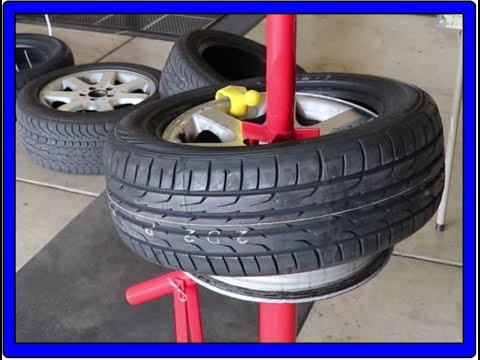 To make sure you buy the correct type of tire, always look for the ST designation. If the tire in question has this mark on it, you can be sure you’re on the right track.
To make sure you buy the correct type of tire, always look for the ST designation. If the tire in question has this mark on it, you can be sure you’re on the right track.
Do you have any friends who use trailers like yours? Ask them what tire make and model they prefer. Call up your mechanic and ask what they’d recommend. You might even ask the tire company what tires they recommend for your specific trailer. You shouldn’t feel the need to follow these recommendations to the letter, but they can be a great jumping-off point for you to decide.
Once you’re armed with your replacement tire, jacking up the trailer is your first step in the process of how to change trailer tires. Before doing this, however, take the precaution of loosening the lugs ahead of time.
You can also loosen the lugs after you have the wheel jacked up, but doing so will leave the tire free to spin while you try to unscrew the nuts. By completing this step while the tire is on the ground, you ensure the tire will stay still.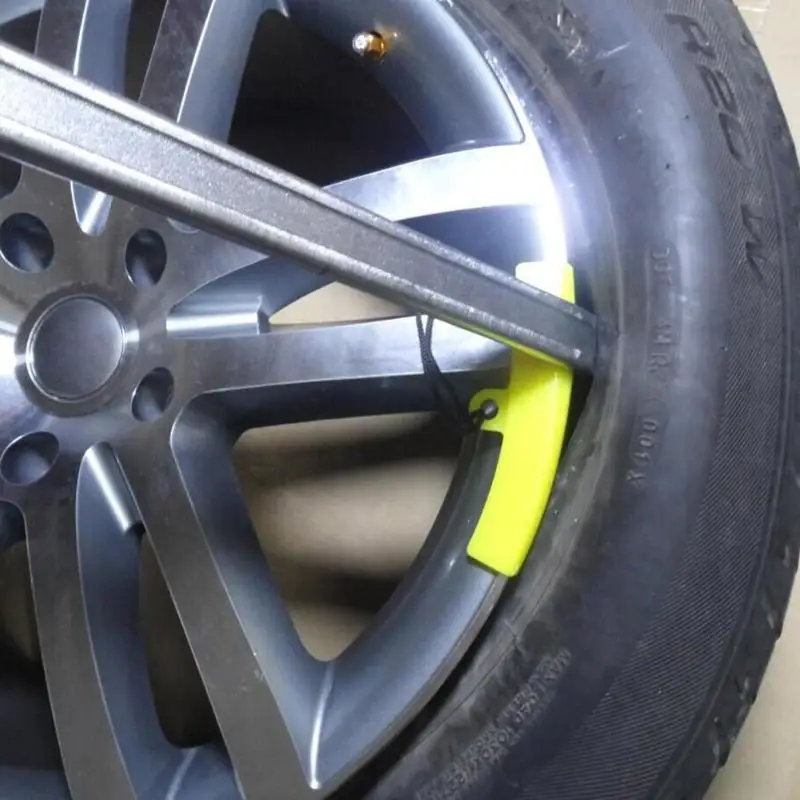 Use a lug wrench to partially unscrew the lug nuts, but don’t remove them yet. Leave them in the wheel, loosened to the point where they’ll be easy to remove once you’re ready.
Use a lug wrench to partially unscrew the lug nuts, but don’t remove them yet. Leave them in the wheel, loosened to the point where they’ll be easy to remove once you’re ready.
When you’re finished loosening the lugs, place the jack under the trailer’s frame, at the back side of the damaged tire. On the other side of the trailer, slide a wheel chock under one of the tires to keep it from sliding around. Then, steadily jack up the trailer until there’s enough room to take the tire off the bolts and get a new tire on again. Keep in mind that if the old tire is flat, you’ll need to jack the trailer higher than you might think. A flat tire doesn’t need much room to slide off the bolts. A new tire will be larger and need more space.
Once you’ve safely jacked up your trailer and you have all your tools ready to go, it’s time to get started on the process of changing the tire itself. Follow these steps, and you can’t go wrong.
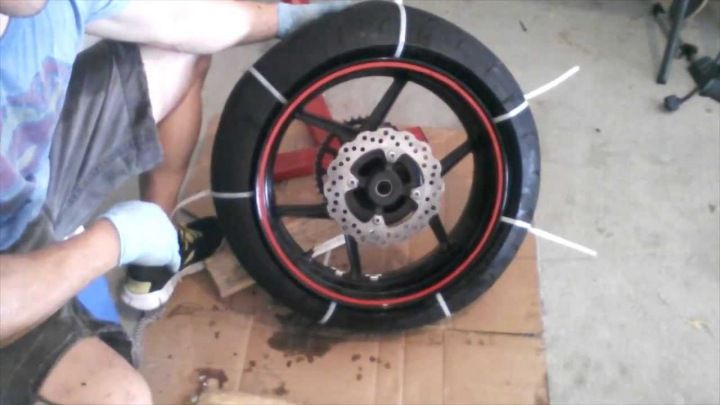 Remove the Tire
Remove the TireWith the tire safely in the air, reach in and remove the lug nuts you loosened earlier. These should come out easily, after which it will be a simple matter to slide the used tire off the lug bolts. Keep the nuts nearby, as you’ll need them again. You can now put the old tire aside, as it has served its purpose.
Once you’ve removed the tire and the wheel hub is bare, this is a perfect time to glance at it and make sure everything still looks normal and functional. Check that the studs and bearings are in good working condition, and reassure yourself that nothing is cracking or buckling. This inspection isn’t necessary to the changing of the tire, but it is a rare opportunity to see the wheel hubs laid bare, so it makes sense to give them a quick once-over while you’re at it.
It’s time to grab that shiny new tire and lower it into place on the lug bolts. If you see anything that seems off — maybe you somehow bought the wrong size or type — now’s the time to notice that and head out to buy the correct tire this time. Give the tire a thorough look to ensure everything seems ordinary before proceeding.
Give the tire a thorough look to ensure everything seems ordinary before proceeding.
Grab those lug nuts you removed earlier and put them back on to secure the new tire in place. You can do the first few turns by hand. You won’t be able to tighten them all the way yet, since you’re only using your hands and the wheel is probably trying to spin in circles. For now, get them as tight as you can, to make sure the tire isn’t going to fall off.
Once the lug nuts are as tight as you can get them with your hands, it’s time to lower the jack until the tire rests flat on the ground. Pull this out from under the trailer and set it aside, and don’t forget to remove the wheel chock from the other side of the trailer as well.
With the added pressure of the tire against the ground, you should have the resistance you need to finish tightening the lug nuts the rest of the way. Grab your lug wrench again, and use this to tighten the lugs to the fullest extent, until they positively won’t move anymore. The last thing you want is for the lug nuts to come loose and the tire to go flying off as you’re driving down the road.
The last thing you want is for the lug nuts to come loose and the tire to go flying off as you’re driving down the road.
Congratulations, you finished the job. The new tire should be securely in place, and shouldn’t need any more maintenance for a long while. All that’s left to do is clean up the tools scattered around and dispose of the old tire. To get rid of a used tire, wait for a bulk trash collecting event in your community and dispose of it then. You might also visit your local mechanic’s shop and ask if they recycle tires. You can even recycle your tire yourself by turning it into a tire swing, a garden planter or even a compost bin.
If you do decide to recycle your tire yourself, make sure to remove the rim and wheel weights before you put your tire to its new use. Cutting the rim away from the tire can be dangerous, however, so don’t attempt this unless you have experience with power tools and feel confident you know what you’re doing.
Sometimes, no matter how many tutorials you read, you may not have the confidence and skill to change a trailer tire yourself. This is entirely natural, and nothing to feel awkward about. Plenty of people seek professional help with their tire replacements every day, and if you choose to do the same, you’ll be in good company. If you’re ready for new tires and you don’t feel up to replacing them on your own, we want to help. Our team here at All Pro Trailer Superstore has years of experience in replacing tires on all kinds of trailers, and we’d be delighted to work with you on your trailer.
This is entirely natural, and nothing to feel awkward about. Plenty of people seek professional help with their tire replacements every day, and if you choose to do the same, you’ll be in good company. If you’re ready for new tires and you don’t feel up to replacing them on your own, we want to help. Our team here at All Pro Trailer Superstore has years of experience in replacing tires on all kinds of trailers, and we’d be delighted to work with you on your trailer.
Tire replacement isn’t the only service we offer, either. Whether your trailer needs inspecting, repairs or some extra customization, we’re glad to help. What if you don’t yet have a trailer, but are thinking of taking the plunge and buying one? We sell trailers as well. Although our headquarters is in Pennsylvania, we’re proud to serve trailer owners, renters and buyers across the Mid-Atlantic and New England area.
Are you ready to get your tires fixed and prepared for your upcoming trip? Bring your trailer into Trailer Superstore today and learn why so many people trust us with their trailer maintenance needs.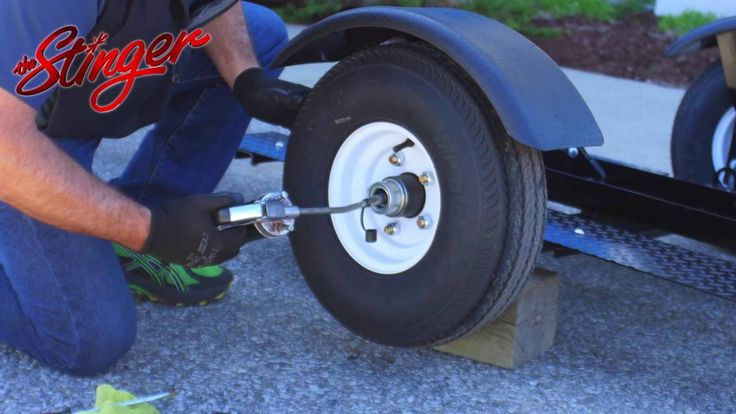
Advertisement
Whether caused by under-inflation — the leading cause of tire failure — or physical damage from running over curbs or road debris, a flat tire on a boat trailer should be regarded as serious as a tire failure on the tow vehicle and addressed immediately. While it's true that towing a boat with a tandem-axle trailer buys you some time to drive your rig a short distance to a suitable place to fix the flat, the tire and rim can suffer additional damage with each revolution and should be repaired ASAP.
1. If you suspect a flat, immediately pull the trailer well off the road onto a level shoulder or area offering an even, hard-topped surface, and park the rig with the emergency brake engaged. Check if the flattened tire allows the jack enough clearance to fit under the frame. If not, place a piece of wood or other solid object (the spare tire/wheel will do in a pinch) in front of the flat tire. Then carefully drive the tow vehicle slowly forward so the trailer tire rolls up atop the brace and is high enough to get the jack into position. Put the vehicle back in park with the emergency brake on.
Check if the flattened tire allows the jack enough clearance to fit under the frame. If not, place a piece of wood or other solid object (the spare tire/wheel will do in a pinch) in front of the flat tire. Then carefully drive the tow vehicle slowly forward so the trailer tire rolls up atop the brace and is high enough to get the jack into position. Put the vehicle back in park with the emergency brake on.
Make sure you carry a wrench sized to fit the trailer wheel's lug nuts.
2. Using the proper size wrench, break the lug nuts free on the wheel of the failed tire. Doing so before you raise the trailer with the jack keeps the wheel from spinning as you loosen the lug nuts.
3. When the nuts are loose, place the jack under the trailer frame on the back side of the damaged tire.
Some boaters carry a separate jack for the trailer, albeit not often a full-sized floor jack. Scissor or bottle jacks rated for the rig's weight work fine.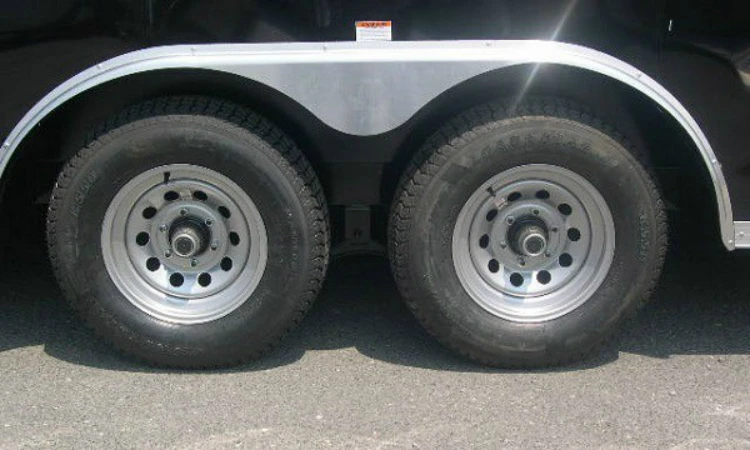
4. Jack up the trailer until the wheel can be taken off the lug bolts, allowing enough clearance to put a fully inflated tire back on, and remove the lug nuts and failed tire from the lug bolts.
Anti-seize lubricant will make loosening the lug nuts on your next tire change much easier.
5. Place the spare tire on the lug bolts, replace, and hand-tighten the lug nuts.
You only need to jack up the trailer enough to remove the flat tire and fit a fully-inflated one on.
6. Release the jack slowly to drop the trailer back down until the tire contacts the road surface, allowing you to tighten the nuts with the lug wrench without the wheel spinning. Tighten the lug nuts in an alternating pattern to assure that each gets fully seated. On a four-lug wheel, tighten the nuts in a 1-3-2-4 pattern; on a five-lug wheel tighten in a 1-3-5-2-4 sequence. Repeat the torqueing order until all the lug nuts are tight to the wheel, and the wheel is tight to the hub.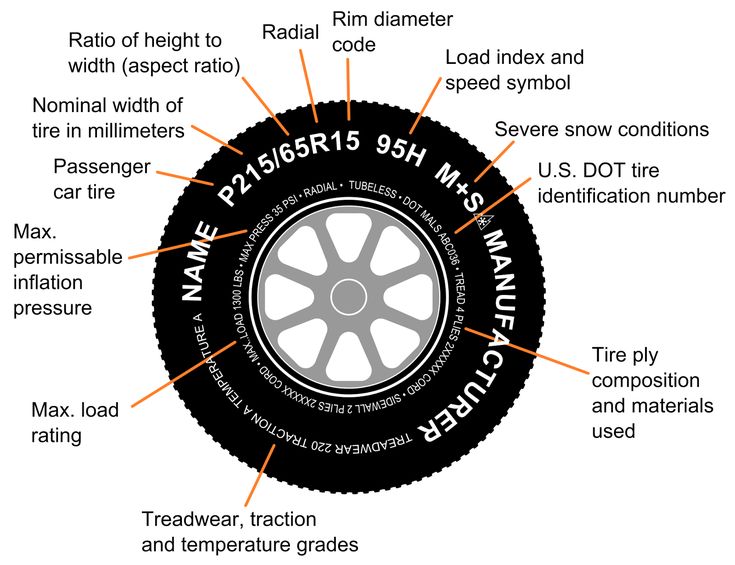
After replacing the tire, slowly release the jack to drop the trailer to the ground.
7. Release the jack, allowing the tire to support its side of the trailer. Then check each lug nut again for tightness before removing the jack.
8. Get the flat tire repaired or replaced as soon as possible, mount it as a spare, or put back into position as a primary tire.
Advertisement
Unfortunately, these days, selling your boat may be rife with attempts from "buyers" trying to fleece you! Here are the red flags for fraud and what to do about it.
Read More
Whether fishing or playing, the Grady-White Adventure 218 is a versatile anomaly among a diverse fleet of small powerboats.
Read More
Keep those trailer tires turning with a good dose of the proper lubrication.
Read More
Click to explore related articles
boats and tow vehiclestrailers and traileringmaintenance
Published: April 2014
Contributing Editor, BoatUS Magazine
A full-time travel and outdoors writer based in Ohio, Dan is in his 20th season hosting the popular syndicated radio show Buckeye Sportsman. He gets around on a pontoon boat and an Aquasport center-console, which he uses for all his DIY editorial projects and fishing features. A USCG Captain (Master 50-ton), he’s a popular speaker at boat and sport shows.
Membership Benefits Include:
Subscription to the print version of BoatUS Magazine
4% back on purchases from West Marine stores or online at WestMarine.com
Discounts on fuel, transient slips, repairs and more at over 1,200 businesses
Deals on cruises, charters, car rentals, hotel stays and more…
All for only $25/year!
Join Today
When purchasing a cultivator for a household or farm, they often look solely at the performance of the unit and engine power. But the running gear of the equipment has a direct impact on the efficiency of work. Each owner must clarify in advance which wheels fit of his model walk-behind tractor .
Factory walk-behind tractors are fully equipped, however, the undercarriage fails over time due to loads. It is important to have at least two pairs of spares in the bins at home wheels on the cultivator cart in order to replace the defective part in time.
In addition to replacing worn out wheels, modernization of the running gear is often required. This must be done in the following cases:
In our store you can choose and buy top wheels for motoblock Neva and other manufacturers.
Before you decide which wheels are best for your walk-behind tractor , it is important to know about their varieties. The undercarriage for the cultivator is available in several versions:
The undercarriage for the cultivator is available in several versions:
In order to clarify how much wheels for a walk-behind tractor , you need to call our contact numbers or go to the catalog on the official website of the store.
When choosing wheels for the Salyut walk-behind tractor and other manufacturers, it is important to consider what land the cultivator will cultivate. For loosening clay soil or in conditions of high humidity, it is recommended to use pneumatic or soil cutters.
When choosing wheels for a walk-behind tractor with a standard size of 8 , it is important to pay attention to the following criteria:
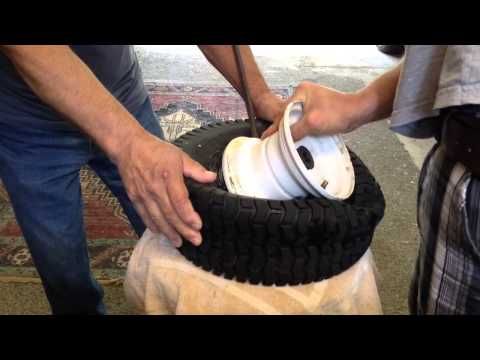 The deeper it is, the higher the maneuverability of the cultivator. For work on the ground use herringbone pattern
The deeper it is, the higher the maneuverability of the cultivator. For work on the ground use herringbone pattern For the primary processing of virgin soil, cast wheels of the walk-behind tractor with a size 13 are better suited. They are not equipped with an internal chamber, so they are not afraid of mechanical damage. It should be borne in mind that such a running traction has a lot of weight, therefore it is suitable for heavy walk-behind tractors.
Our store offers a wide range of wheels for a walk-behind tractor from trusted manufacturers, including Neva . We guarantee the high quality of each unit and offer the most favorable price , because we work directly with suppliers without intermediaries.
We guarantee the high quality of each unit and offer the most favorable price , because we work directly with suppliers without intermediaries.
If you have any difficulties, just call the contact numbers. Professional consultants with experience will help you choose the best model, including big wheels for the cart of the motor-block at the most favorable cost.
The driving traction must provide the cultivator with high maneuverability, while not damaging the plantings and seedlings on the site!
Experiments show that the degree of patency of special equipment, including tank trucks, can be dramatically improved.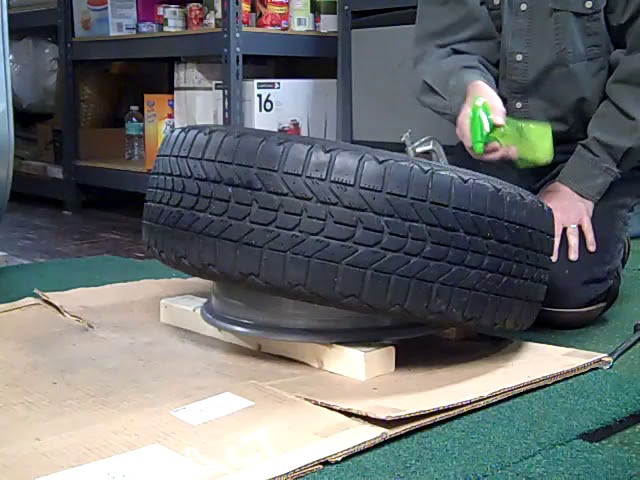 For this purpose, twin (double or dual) conventional road-type tires, the size of which is selected based on the maximum load capacity on a solid road, are replaced with special single tires, which have a large profile, and use a pressure adjustment system in them.
For this purpose, twin (double or dual) conventional road-type tires, the size of which is selected based on the maximum load capacity on a solid road, are replaced with special single tires, which have a large profile, and use a pressure adjustment system in them.
For the first time, the installation of single tires from a scientific point of view was explained during the creation of the ZIL-157, the first off-road vehicle (not increased).
The experiments that preceded the appearance of this car led to the conclusion that it is possible to increase the cross-country ability of a wheeled truck (flatbed, tractor, dump truck). ZIL-157 on the sand had a cross-country ability no less than a tracked vehicle, and its cross-country ability on different types of soil and on snow significantly exceeds that of any previous generation vehicle with increased cross-country ability.
The installation of tires, the set of which includes large-diameter discs and load capacity, solves the problem with the lack of ground clearance for special equipment and increases its cross-country ability. This option is usually needed by trucks and special vehicles that require maximum performance in heavy road conditions, where the traditional two-row rear bogie or axle tires make it difficult to travel on a haul road, off-road or snowy road in northern terrain.
This option is usually needed by trucks and special vehicles that require maximum performance in heavy road conditions, where the traditional two-row rear bogie or axle tires make it difficult to travel on a haul road, off-road or snowy road in northern terrain.
| Double busbar |
| Single busbar |
Single row tire with large diameter and considerable width. They also have such an important feature as a change in internal pressure depending on the conditions on the road. This implies the possibility of doubling the load capacity of the tire at a limited speed.
The use of special tires with a large diameter and profile with adjustable internal pressure allows, on weak soil, to significantly reduce the pressure in them to a value at which the operation of the tires is accompanied by significant deformation. As a result, the area of contact between the wheels and the soil increases significantly, the value of the specific pressure that the wheels produce on the ground decreases, and the depth of the track and the degree of resistance to movement also decrease. During the rolling of the wheels on the deformed tires, the compaction of the soil in the rut and the adhesion of the wheel to the soil improved. These are decisive components in improving traction and increasing the cross-country ability of the truck.
As a result, the area of contact between the wheels and the soil increases significantly, the value of the specific pressure that the wheels produce on the ground decreases, and the depth of the track and the degree of resistance to movement also decrease. During the rolling of the wheels on the deformed tires, the compaction of the soil in the rut and the adhesion of the wheel to the soil improved. These are decisive components in improving traction and increasing the cross-country ability of the truck.
Thanks to the installation of a single tire, it is possible to maintain the load capacity with a sharp rise in ground clearance while improving patency, including due to off-road aggressive tread.
The use of high-profile tires results in a change in the truck's off-road characteristics:
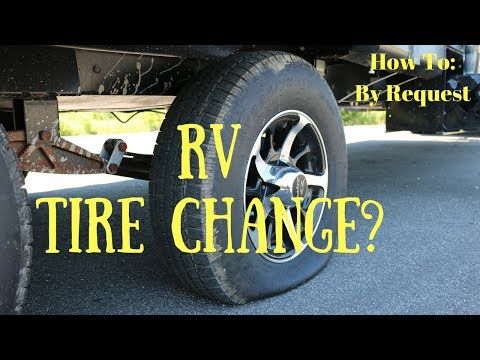
Please note that the replacement of the tire set also requires the replacement of the rims. Even in the case when the size matches, discs with higher strength and load capacity are installed instead, usually collapsible and composite.
In the case when the rear axle of the truck allows the use of both double and single tires on the rear bogie, with different dimensions between the wheels of the front and rear axles, it is possible to use different tires in different climatic and road conditions on the same vehicle. With the help of such a technical solution, it is possible to independently select and install different wheels, taking into account the season, weather conditions and operating conditions. For example, in winter, when the road has a hard surface, it is advisable to use a dual-tire tire, which allows you to save fuel, while during a thaw it is possible to use a single-tire tire, which increases the vehicle's off-road capability.
Question: What is needed to install single tires instead of double tires?
Answer: We need car rims, bypass tapes and the tires themselves.